- Analyst of nanofluids massic temperature quality assessment of artificial intelligence
Tawfiq Al-Mughanama,* and Vineet Tirthb
aDepartment of Mechanical Engineering, College of Engineering, King Faisal University, Al-Ahsa 31982, Kingdom of Saudi Arabia
bMechanical Engineering Department, College of Engineering, King Khalid University, Abha 61421, Asir, Kingdom of Saudi ArabiaThis article is an open access article distributed under the terms of the Creative Commons Attribution Non-Commercial License (http://creativecommons.org/licenses/by-nc/4.0) which permits unrestricted non-commercial use, distribution, and reproduction in any medium, provided the original work is properly cited.
Nanofluids are a class of fluids that contain a small number of nanoparticles, which have unique thermal and physical properties that make them suitable for various industrial and biomedical applications. However, the quality of nanofluids is often affected by factors such as temperature, concentration, and stability, which can affect their performance. This study aimed to develop an AI-based method for assessing the massic temperature quality of nanofluids, which can be used to optimize their performance and ensure their stability. The study used a dataset of massic temperature measurements of nanofluids, which were collected from experiments. The dataset was then preprocessed and used to train a machine learning model, which was able to predict the massic temperature of nanofluids based on their concentration and stability. The results showed that the AI-based method was able to accurately predict the massic temperature of nanofluids, with a mean absolute error of less than 1%. The study also investigated the effect of different factors on the massic temperature of nanofluids, such as the type of nanoparticle, the size of the nanoparticle, and the method of preparation. The results showed that these factors have a significant impact on the massic temperature of nanofluids and that the AI-based method can be used to optimize the performance of nanofluids by adjusting these factors. The study utilizes a Mean Absolute Error (MAE) to ensure better consistency between predicted and observed values. The results indicate that the heat capacity of the nanofluids improved by 57%.
Keywords: Specific heat capacity, Nanofluid, Artificial neural network, Preparation parameters, Thermal conductivity
Increasing thermal transfers and gives high across a wide variety of applications need the use of fluid cooling applications. This includes power devices, renewables, transport, and hospital instruments. Due to rising temperatures, conventional fluid heat exchange efficiency must be improved. Conventional heat exchange fluid may be converted into nanofluids by dispersing nanometer-sized solid particles at relatively low particle volume concentrations [1]. For almost 20 years, scientists have considered using water nanofluid as effective heat transfer fluids due to their greater solution resilience comparable to micron-sized fine materials, their flowability freely without clogging the system, and their enhanced thermo-physical characteristics.
Changing the type of nanoparticles, its shape and size, the solution, the quantity of surfactant, and other elements in a nano - fluid allows for it to be optimized for a wide range of specific uses [2]. The heat transfer of the heat transfer is widely acknowledged to be a significant factor in the efficiency of heat transfer. The poor thermally conduction of most fluids is improved by the presence of solid particles with substantially higher specific heat [3]. Small small particles may be used to improve a liquid's heat capacity when added to a solution without affecting the fluid's ability to transport heat [4]. The magnitude of the impacts seen in the existing literature ranges from a few percentage points to hundreds of percentage points per volume of nanoparticles.
The heat transmission capacities of popular heat exchangers including water, ethylene glycol, and motor oil are severely constrained by their modest heat transfer qualities. Many scientists have been looking at methods to improve heat transfer fluids' thermal efficiency [5]. The total thermal efficiency of the heat transfer medium may be improved by adding particles of highly high thermal conductivity materials, such as carbon, metal, or metal oxides [6]. To create water nanofluid, tiny particles (less than 100 nm in size) are dispersed throughout a solvent such as water, ethylene glycol, or propylene glycol. So when nanoparticle' heat transfer rate is many times greater than the liquid, this effect is visible [7]. Some of the advantages of nanotechnology over bigger particles include their stability in fluid, their appropriateness for use in microchannels, and the decreased wear on equipment that follows from their minuscule size [8]. To take advantage of these advantages of tiny particle size, however, aggregation of particles must be kept to a minimum.
This proposed work involves the use of artificial intelligence techniques (ANN) to analyze the mass and temperature characteristics of nanofluids, which are fluids that contain nanoparticles suspended in a liquid. The use of artificial intelligence in this field potentially lead to new insights and improved understanding of the behavior of nanofluids.
Objective:
The Objective of this study is as follows;
1. To find the best combinations of factors that influence the effective thermal conductivities,
2. To find the nanoparticle volume fraction, their size, the heat at which they are dispersed,
3. To determine the ratio of their heat capacity to that of the base fluid
Ur Rehman et al.[1] Nanomaterial flow near the stagnation point in three-dimensional MHD under the impact of an exponentially extending surface was the subject of a thermophysical study. Next, we consider the heat transfer characteristics of a nanofluid over a narrowing highly permeable sheet with heat and mass fluxes, and it is pointed out that, just as the production of turbulence grows in the case of an exponential rate shrinking sheet compared to that of a linearly shrinking sheet, so does the value of suction needed to contain the generated vorticity within the boundary layer. Lund et al. [2] Mixed convection movement of a magneto- hydrodynamic (MHD) nanofluid across vertically decreasing and stretching surfaces has been solved in four dimensions, and its safety has been analyzed.
Naddaf et al. [3]. The two-stage design process was used for all nano - fluids. The effectiveness of the specimens' heat transmission was measured in a laminar flow regime across a straight pipe heated electrically. The scientists noted that covalently functionalized nanoadditives provide a greater h enhancement than non-covalent ones. According to the results presented, the h value of the hybrid OA-MWCNT:GNP/diesel oil nanofluid is often lower than that of the comparable mono alternatives. The maximum typical h rise is seen in a mono nanofluid of 0.53 wt percent OA-GNP/ water. Maximum increases in P recorded by the authors are 9.8 percent for the 0.7 wt percent OA-MWCNT/diesel oil nanofluid, which is within the range of what would be considered to be physiologically acceptable. With a maximum increase of 8.5%, the 0.49 wt% OA-GNP/water mono nanofluid also has the lowest P of the OA-functionalized nanofluids.
Gupta et al. [4] compared the properties of a hybrid nanoadditive composed of silver and multi-walled carbon nanotubes (MWCNT) in a 3:1 ratio with those of pure silver and pure MWCNT. Two-step construction of hybrid and mono nanofluids was made possible by dispersions of the aforementioned nanoadditives in water at total concentrations of 0.02, 0.05, 0.1, 0.2, and 0.5 wt percent. The compounds were examined while flowing through a tape-heated copper tube at predetermined Reynolds numbers (Re) ranging from 1275 to 2200. (mostly in laminar regime). Maximum h enhancements were seen at Re = 2200 and the greatest concentration (0.5 wt percent) that was analyzed. The hybrid sample and the Ag/ water mono nanofluid came in second and third, respectively, to the MWCNT/water mono nanofluid, which increased h by 67.5%. Regarding P enhancements, we are given zero hints.
Hentschke, R. et al. [5] A alternative model is suggested in place of a widely held belief that the presence of nanolayers around the nanoparticles is what causes the significant rise in a nanofluid's specific heat capacity. The model presupposes that the nano- particles' impact on the liquid around them has a wide field of effect. As the concentration of nanoparticles rises, interactions between the adjacent long-range interfacial layers may occur [5]. There seems to be no alternative theoretical explanation for the specific heat maximum that has been reported by several groups, yet this may explain it.
Ali, N. et al. [6] Investigations were done on the thermophysical characteristics and dispersion stability of nanofluids based on graphene. This experiment was done to find out how the suspension's stabilising qualities and effective properties were affected by the production temperature, nanomaterial concentration, and surfactant ratio.
Additionally, it was discovered that the preparation temperature is the main factor affecting the viscosity and thermal conductivity of nanofluids, leading to the highest viscosity reduction and rise in thermal conductivity being seen [6].
Subaşı, A et al. [7] the author objectives were to create an Artificial Neural Networks (ANN) based estimator that can be used to forecast the specific heat of deionized water-based CuO + MWCNT, MgO + MWCNT, and SnO2 + MWCNT hybrid nanofluids, as well as to examine the usefulness of the ANN-based estimators. It has been shown that the ANN-based estimator performs better than the conventional correlation at predicting the specific heat of the hybrid nanofluids. Therefore, it has been determined that employing the ANN-based estimator to calculate the specific heat of nanofluids would allow for more accurate and realistic computations.
Qamar, A et al. [8] studied the performance of heat transmission and pressure drop characteristics of ZnO/DIW-based nanofluids in horizontal micro tubes of various diameters. Different nanoparticle mass concentrations and different nanofluid flow rates were explored. At a constant temperature and nanoparticle concentration, the greatest increases in thermal conductivity and viscosity of stable nanofluids were 18.27% and 20.31%, respectively.
Shi, L et al. [9] investigated the characteristics of hybrid nanofluids, as prospective heat transfer fluids, are impacted by a variety of factors, including temperature, volume fraction, and the size of the solid components. This article reviews the characteristics of nanofluids with hybrid nanostructures as well as the theories that have been suggested to explain these characteristics [9]. The trend of fluctuations in the specific heat relies on the base fluid, while a rise in the volume percentage of particles improves thermal conductivity and dynamic viscosity. Additionally, when the temperature rises, the thermal conductivity rises while the dynamic viscosity falls.
The proposed methodology involves the pre-processing of datasets that used to train an optimal multi-layer perceptron neural network on turbulent flow of non-Newtonian nanofluids in a circular tube with constant wall temperature.
The overall process of the methodology is shown in the below flow diagram.
An optimal multi-layer perceptron neural network was trained using experimental data on turbulent flow of non-Newtonian nanofluids in a circular tube with constant wall temperature. The obtained ANN model is based on our prior experimental data. It took some iteration to get the best neural network design. The ANN takes in a single set of data and links it to one or more hidden nodes and subsequent output units. The hidden layer of a system is made up of linked neurons that provide widespread mobile communication [24]. Those nerve cells are the ones responsible for relaying weight information. The neurons in one layer are linked to those in the layer below it. The input layer of the human brain is where information is displayed. Outputs from a neural cable network will be shown for a set of input feature vectors. These systems are able to calculate causal relationships between outputs and inputs by using hidden nodes. The following diagram depicts the construction of the artificial neural network used to create Fig. 5.
The depth of the issue should determine the optimal number of hidden layers. Almost every problem that can be broken down into layers eventually requires a hidden layer. For optimal performance, it is recommended to start with a minimal number of hidden layer neurons and gradually increase that number via trial and error. The human mind is presented with a value system consisting of inputs and expected outcomes. Choosing input variables affects the output features that match those variables. Rear has been successfully used to model genetic variation in previous studies [25].
Essentially, the activation function reduces the models for network error by applying a difference to it.

When estimation and goal values are used, values of ( j) and ( j) are obtained. The “n” variable is used to provide the outputs node, while the “k” variable is used to specify the amount of training data.
In the commencement of each A.N. command, the weight is randomly generated. Errors are detected by changing the weights.

The complementary quantities of "(n)" and "(n − 1)" Weight values rise from I to J in adjacent iteration, while α and β are the learning rate and driving force for the algorithm. Adequate assessment and meaningful educational rate adjustments are needed for the appropriate results of both the training algorithm. Various literature references previously published ANN models on nutrient removal in a biological therapy. First experimental data were normalized between 0 and 1.

The data is then arbitrarily split into a training set (75 percent), a validation set (5 percent), and a test set (10 percent) (20 percent). Typically, an ANN's design is decided by a process of trial and error. First, we determined how many hidden layers would be used and how many neurons would be located in each. Afterward, a training method was used to educate the network [26]. The optimal activation functions for the hidden and output layers were determined by varying the activation functions and measuring the effect on the ANN's performance [27]. The network was trained with several numbers of hidden neurons, and its performance was analyzed to discover the optimal number of hidden neurons. After that, we experimented with different configurations of hidden layers to find what worked best. After that, we used trial and error to figure out what activation function of further hidden layers worked best. Each network was trained 15 times to gauge its consistency. Last but not least, the PSO method is employed to find optimal values for ANN parameters rather than the typical training procedures (weights and biases).
Researchers can see the ANN architecture, shown in Fig. 5, which consists of two hidden layers, each with 6 and 9 neurons. The perceptron of the output layer is linear, while the training algorithm of the two hidden layers is hyperbolic tangent sigmoid transfer function (tansig) (purelin). The MSE metric was used to measure network efficiency [27]. The performance of the ANN is evaluated by calculating its mean squared error. The Nusselt number is the output of an artificial neural network (ANN) that takes as inputs the nanofluid percentage, the Reynolds number, and the Prandtl number.
Preparation of Nanofluid
In this study, nanofluid was prepared using a two-stage process. We ordered Al2O3 nanoparticles from SRL lab in India with an APS (Average Particle Size) of 25 nm. Tabulated in Table 1 are the defining characteristics of the Al2O3 nanoparticle [10]. As a foundational medium, we use a fluid composition of water and ethylene glycol (by volume) in a 50:50 ratio. The nanoparticle concentrations of 0.2%, 0.6%, and 1% by volume were chosen and their matching nanofluids were made. Nanoparticles' volume fractional abundance was determined [11]. When creating a stable colloidal dispersion, we first used magnetic stirring to ensure that the colloid solution was well mixed, and then we used ultrasonication at a specific rate to further break up the colloidal particles [12]. In Fig. 1 we see a block diagram depicting the nanofluid preparation procedure. So, Surfactant SDBS was also utilized, albeit at a much lower concentration (1/10th the nanoparticles' weight) [12]. When the sonication procedure was finished, the resulting nanofluid was ready for analysis. Increasing the density of volume

Several experiment elements were fastened to the motor. 8 K-type thermocouples, 2 wire thermocouples, a temperature sensor display, and a rot meter were utilized in conjunction with a 3.75 kW four-stroke diesel engine. In Fig. 2, we see a simplified depiction of the setup used in the experiment. Two different temperature gauges were put on the flow line. The temperature at the radiator's intake was measured by one, while the temperature at the output was measured by the other. A rotameter and control valve were put near the engine inlet to monitor and regulate the flow of working fluid. Since there were four stagger rows of tube in the heater, in each row two wire thermometers were fitted so as to measure the wall temperature of radiator tubes.
After measuring the wall temperature of each of the seven tubes, an average was determined. To further cooling the fluid within the tube, a blower fan was also added to suck in air from the other side of the radiator. This air would then absorb the heat coming off the tube's wall and distribute it into the surrounding fluid. Due to this, the temperature drop was most noticeable near the radiator's outlet.
The diameter of the tube was so small, and it was made out of such a highly conductive substance, that the temperature gradient between its inside and outside was negligible [13]. Therefore, they were both attributed to having the same temperature. Surfaces heat transfer rate warmed ambient air, which was sucked in by a fan. In this case, we calculated the overall heat exchange between the fluid and the tube wall [14]. The significance of the ubiquitous 'h' in this line cannot be overstated. The rate of heat transmission or absorption per unit of contact area and drop in temperature was ensured by this characteristic. Increasing the heat transfer coefficient increases heat transmission.
Influencing of Nanofluid Parameters
Nanofluid's key thermophysical qualities (thermal conductivity and viscosity) and how they are affected by the several factors that define it [15]. The primary factors influencing the thermo physical characteristics of nanofluids are summarized in Fig. 3.
Methods of Preparation
It is important to briefly describe the ways of manufacture of a nanofluid before beginning the examination of the primary characteristics defining nanofluids, since these procedures have a major impact on the stability of the colloidal suspension and its thermo physical properties [16]. Therefore, the preparation procedure is crucial to achieving high-performance nanofluids. There are many other approaches that may be taken, but they can be broadly classified into two groups based on the number of processes involved.
Nanoparticle Concentration
One of the primary factors determining the thermo - physical characteristics of the nanofluid is the quantity of nanoparticle disseminated in the base fluid, represented as a volumetric or a mass fraction. Measurements of thermophysical characteristics of nanoparticles are almost always correlated with their concentration in a given study [17]. With certain exceptions, greater concentration often results in higher thermal conductivity and viscosity. While greater thermal conductivity enhances heat exchange, greater viscosity worsens heat exchange and increases the amount of energy needed to circulate the nanofluid, due to the higher friction factor. This poses a challenge in terms of the uses of the nanofluid [18]. Therefore, these two features should be taken into account simultaneously while creating a nanofluids, with the goal of finding the circumstances that maximize the fluid's overall performance.
Nanoparticle Size
Many research has investigated how the size of nanoparticles affects the nanofluids' thermal conductivity and viscosity [19]. How nanoparticles are made and distributed in the base fluid determines their final size. Clusters of more or less compact particles may develop within a fluid, leading to a range in nanoparticle size that may be altered by sonication: increasing the sonication period can decrease particle size, as has been shown both theoretically and practically. Detection methods are quite helpful for regulating the size and form of the nanoparticles suspended in the base fluid.
Nanoparticle Shape
Nanomaterials form, in addition to size, is a morpho- logical factor that may affect nanofluid characteristics [20]. As for the impact on thermal conductivity and viscosity, there are a few papers out there that provide evidence for it. Figure 4 displays the outcomes achieved with cubic, rod, and spherical nanoparticles in a TiO2 water-based nanofluid to demonstrate the impact of nanoparticle shape.
The thermal conductivity increases dramatically from around 20% at 303 K to about 60% at 353 K as one moves from cubic to spherical nanoparticles [21]. The authors hypothesize that the improved heat transmission is due to the variable surface to volume ratios for the various forms. The form of nanoparticles also has an effect on the viscosity of a solution.
Main Energy-Related Applications of Nanofluids
As can be seen in Fig. 5, nanofluids may be used to improve the efficiency of a variety of power materials and techniques, such as solar thermal collectors, air conditioning systems, and heat pipes. To illustrate, we tested the efficiency of an indirect solar cooker using three distinct nanofluids and compared them to a control group using thermal oil devoid of nanoparticles. They found that increasing the heat oil's efficiency by 1.17, 3.54, and 4.27 percentage points, respectively, was possible by adding SiO2, TiO2, and SiC/oil. Water and Cu/water nanofluid were used to evaluate the performance of a spirally-coiled twisted-tube. Maximum device performance indexes were determined to be 1.39 for water and 1.88 for the nanofluid. TiO2/water nanofluid was used as a coolant in a vehicle radiator, and a 47 percent improvement in performance was noticed as compared to utilizing plain water. nanofluid as an exterior cooling jacket next to the air conditioner's condenser [22]. The coefficient of performance was improved by 29.4 and 22.1% when utilizing nanolfuids composed of 5 percent Cu/water and 5 percent Al2O3/water, respectively. Heat pipes are another kind of energy-related equipment that might benefit greatly from the use of nanofluids. Researchers used a pulsating heat pipe to test the effects of carbon oxide/water and found that, under optimal conditions, the nanofluid improved temperature efficiency by up to 54.34 percent compared to using only water. In order to model the thermal conductivity of nanofluids, researchers have turned to a variety of tools, including as regressive correlations, ANNs, and support vector machines (SVMs) (SVMs). Researchers found that AI-based models were more accurate than correlational ones [23]. The ANN model had an R2 of 0.9996, whereas the correlation model had an R2 of 0.9862. Prediction models used for the viscous forces of nanofluids have shown that those based on ANNs are more accurate than those based on correlations. Fig. 6
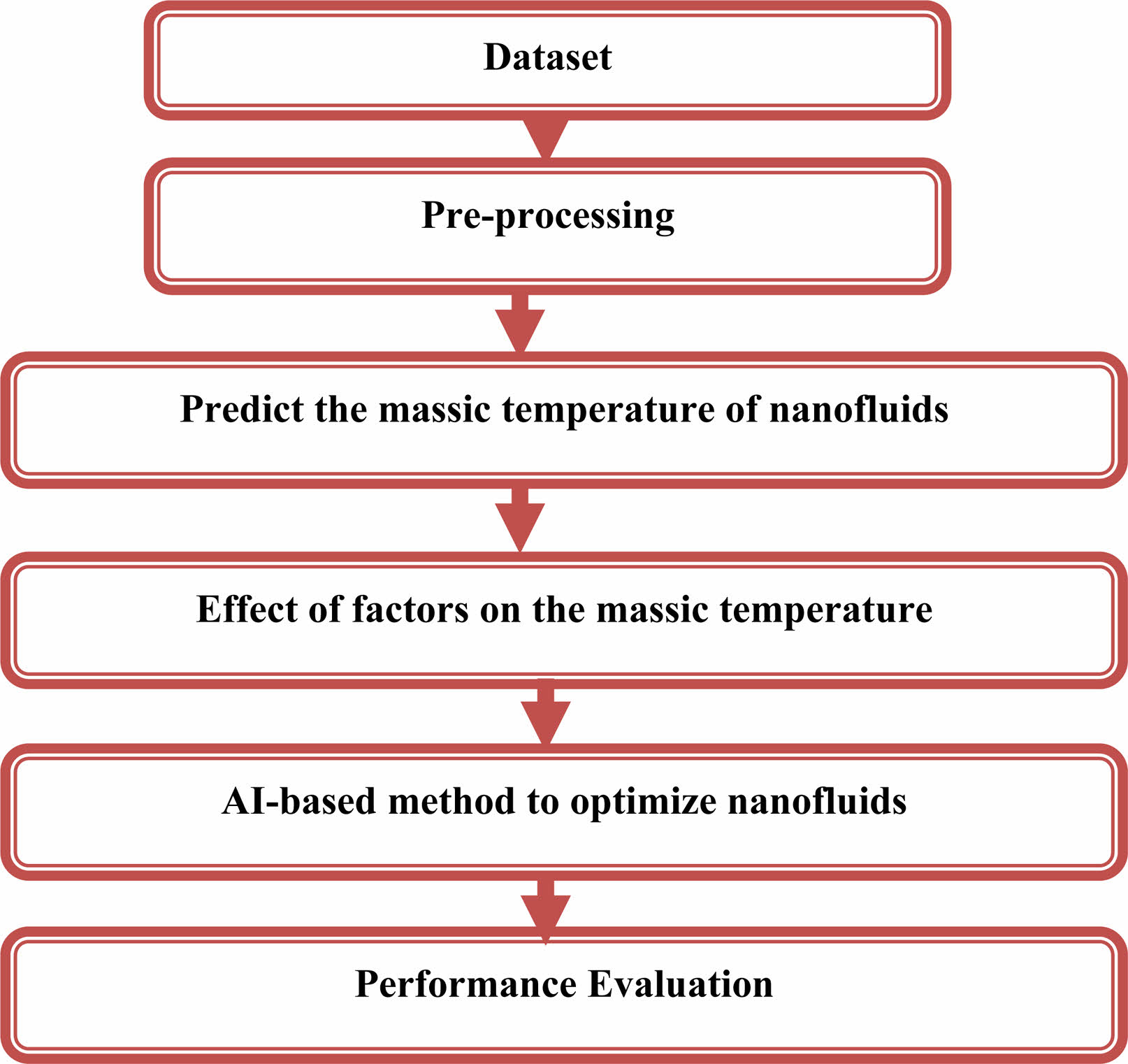
|
Fig. 1 Flow diagram. |
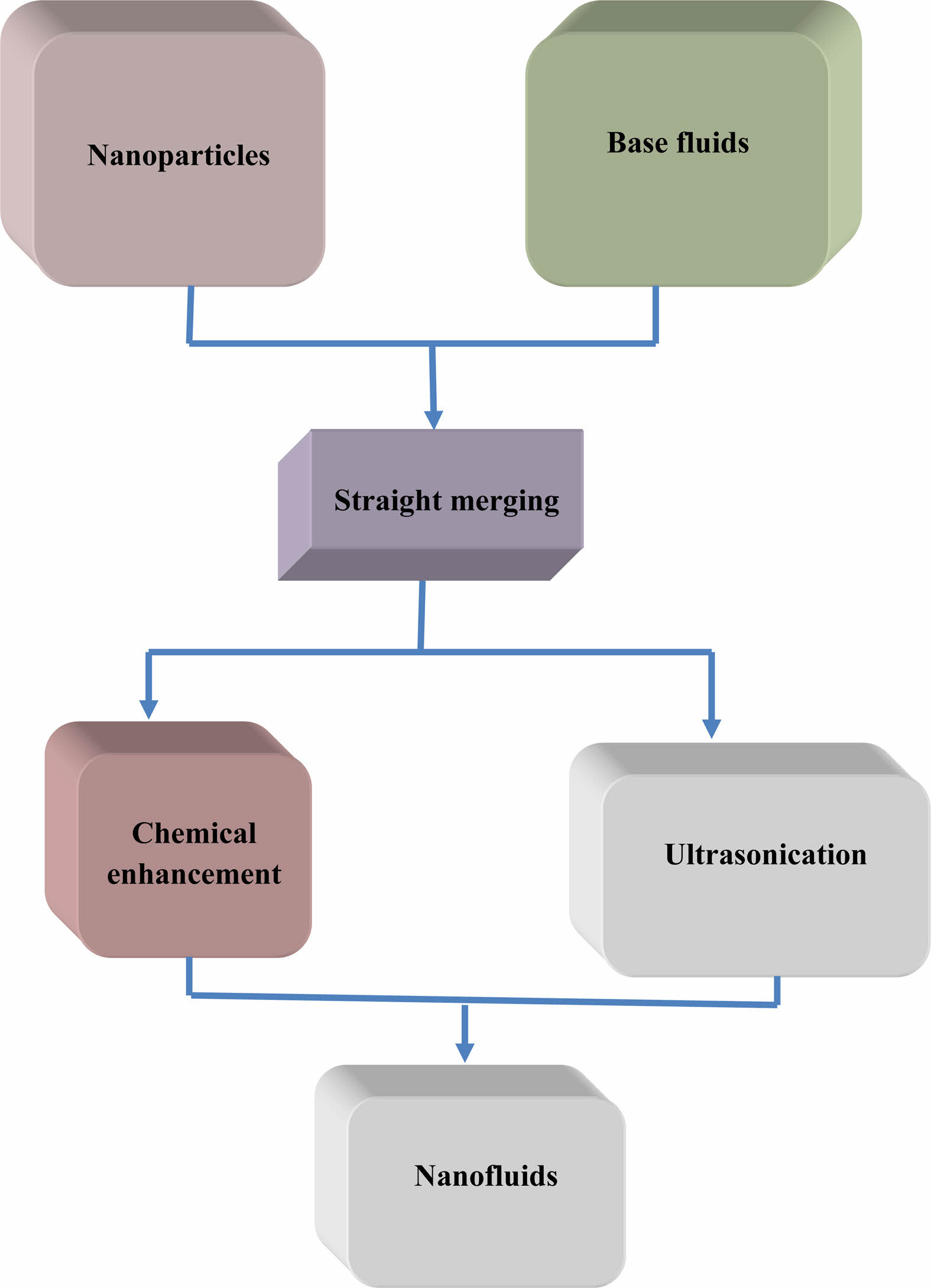
|
Fig. 2 Architecture of Artificial Neural Network. |
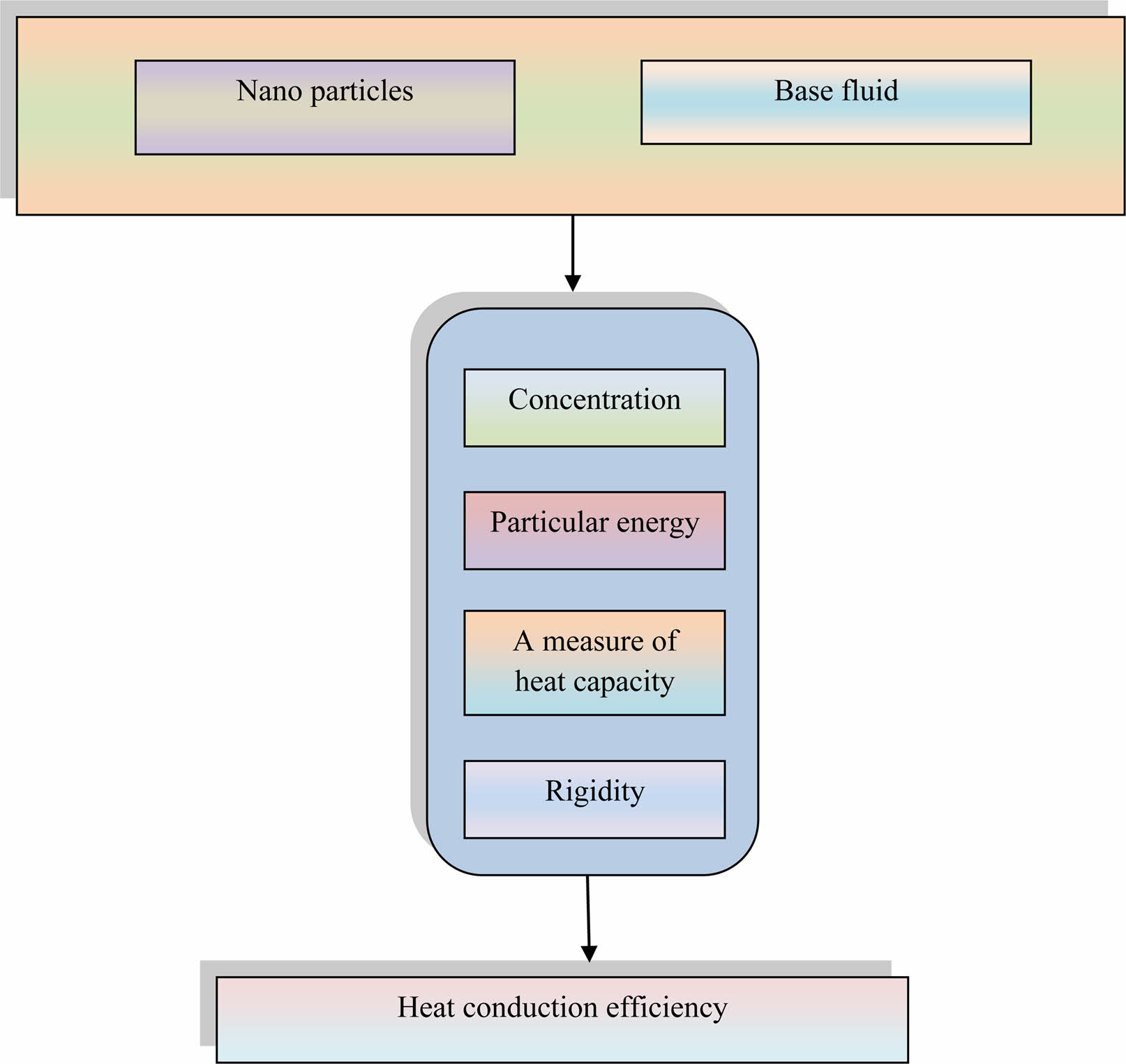
|
Fig. 3 Preparation of Nanofluids. |
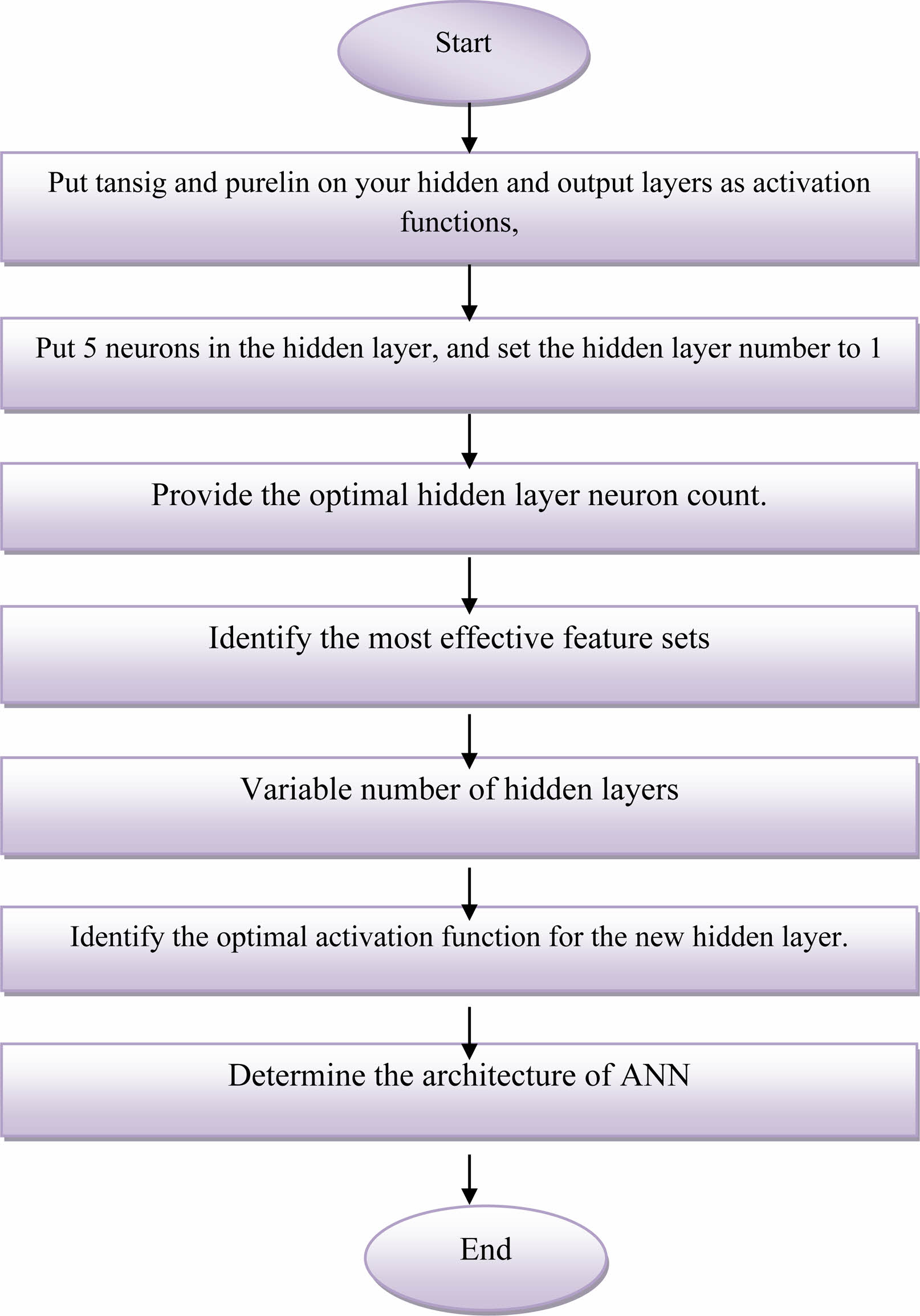
|
Fig. 4 Primary factors influencing the thermo physical characteristics of Nano fluids. |
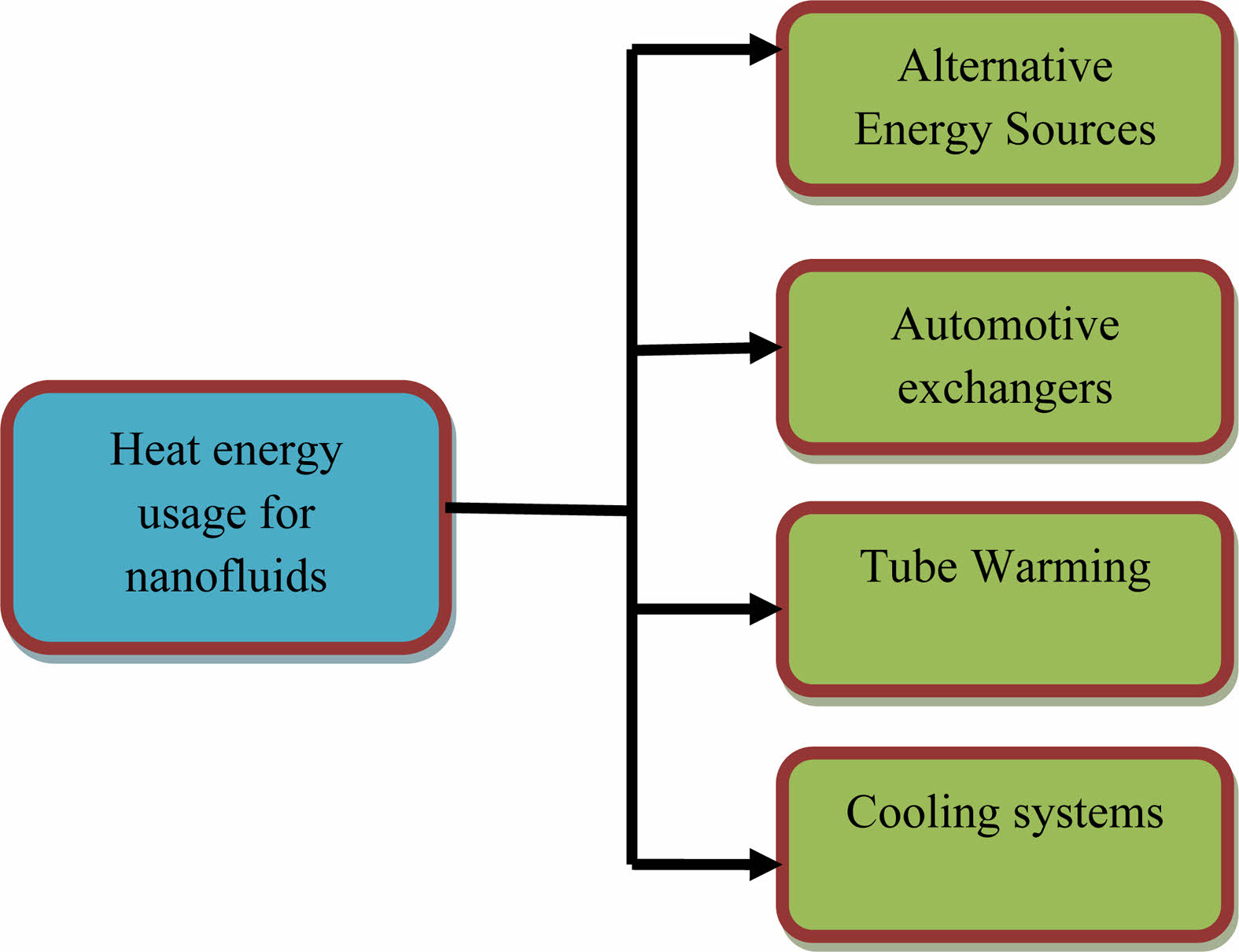
|
Fig. 5 Flow diagram for ANN. |
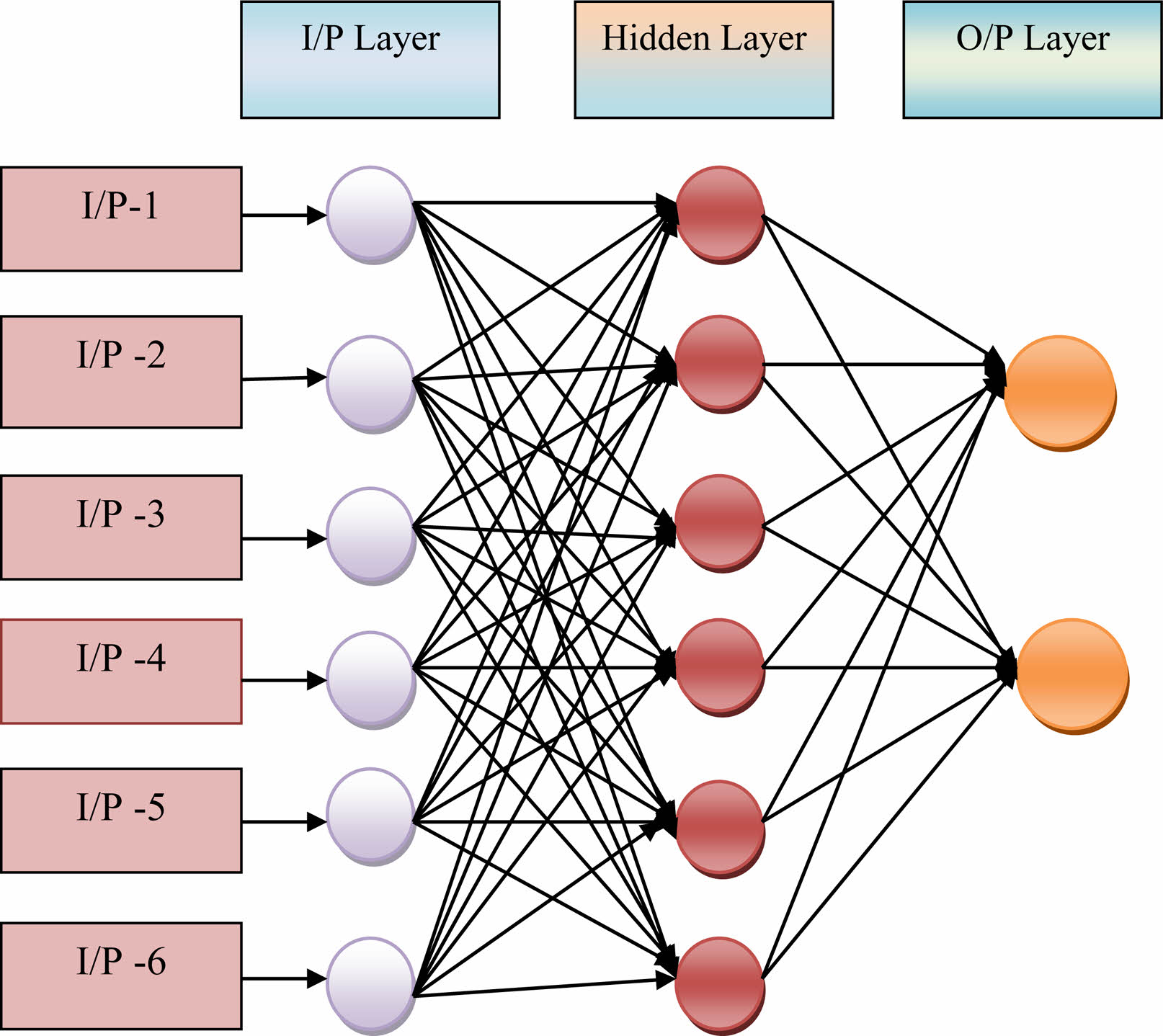
|
Fig. 6 Energy-Related Applications of Nanofluids. |
|
Table 1 Relationship between concentration and specific heat of GN/water-EG Nano fluid. |
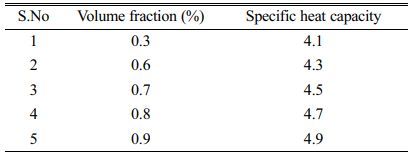
The difference between the amount of heat needed to raise the temperature of a sample and a reference is determined as a function of temperature using the thermo-analytical method known as differential scanning calorimetry (DSC). Throughout the experiment, the sample and reference are both kept at temperatures that are virtually identical. Due to its simplicity, quick measurement periods, and appropriate accuracy, DSC is a measuring method that is often used to determine specific heat capacity.
Materials are described using their specific heat capacities, which are cited in data sheets.
Nanofluids' High Relative Specific Heat
One of the factors that significantly affect a nanofluid’s heat transmission capability is its specific heat capacity. Generally speaking, the specific heat is altered when nano-sized solid objects are suspended in a base fluid. Reduced or increased specific heat, respectively, might be beneficial depending on the context. The particular heat varies based on a number of factors that are evaluated and described below. For instance, particle concentration has a significant role in the observed range of specific heat. Graphene nanoplatelet/water-EG specific heat was measured over a range of solid phase concentrations.
Table 1 and Fig. 7 show that the specific heat of the nanofluids decreased with increasing volume fraction. Take into account not only the weight percentage as well as the base fluid as well as the temperature when determining the specific heat capacity of a nanofluid. Several factors, notably volume concentration, base fluid, and pressure, influence the heat capacity of nanofluids. The effect of dispersion SiO2 particles was discussed in connection to the use of several base fluids, including glycerol (GC), ethylene glycol (EG), and their combination (GC/EG), as well as concentrations.
Table 2 and Fig. 8 show that SVM achieved the best accuracy, followed closely by ANN, based on values of root mean squared error (RMSE). An further study modeled the specific heat capacity of EG-based nanofluids containing CuO and Al2O3 particles using a support vector machine (SVM). The model's inputs were temperature, solid phase volume percent, and the specific heat capacities of the base fluid and nano- particles. A Bayesian technique was used to determine the best hyper parameters for their model, allowing for maximum precision.
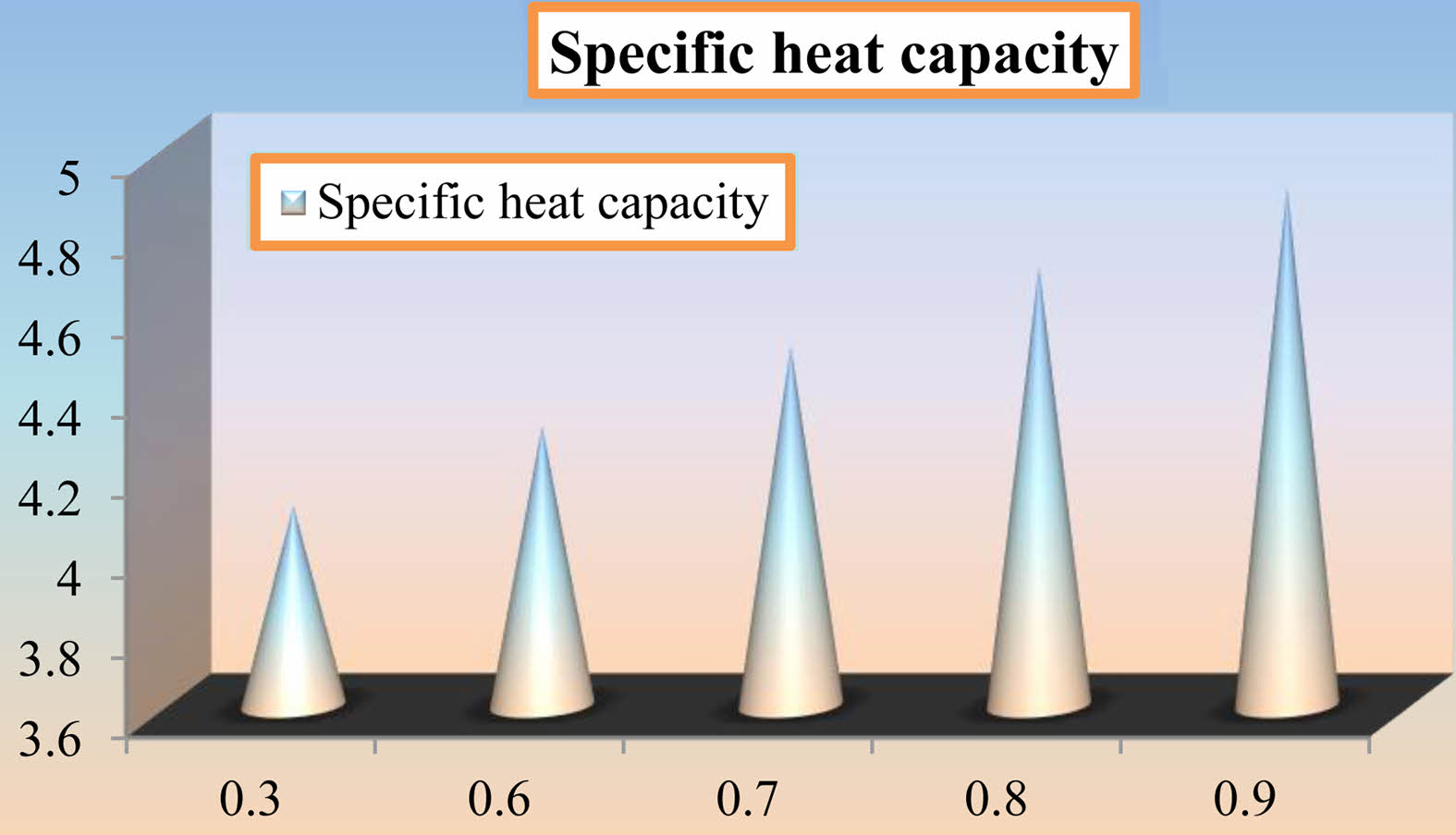
|
Fig. 7 Relationship between concentration and specific heat of GN/water-EG nanofluid. |
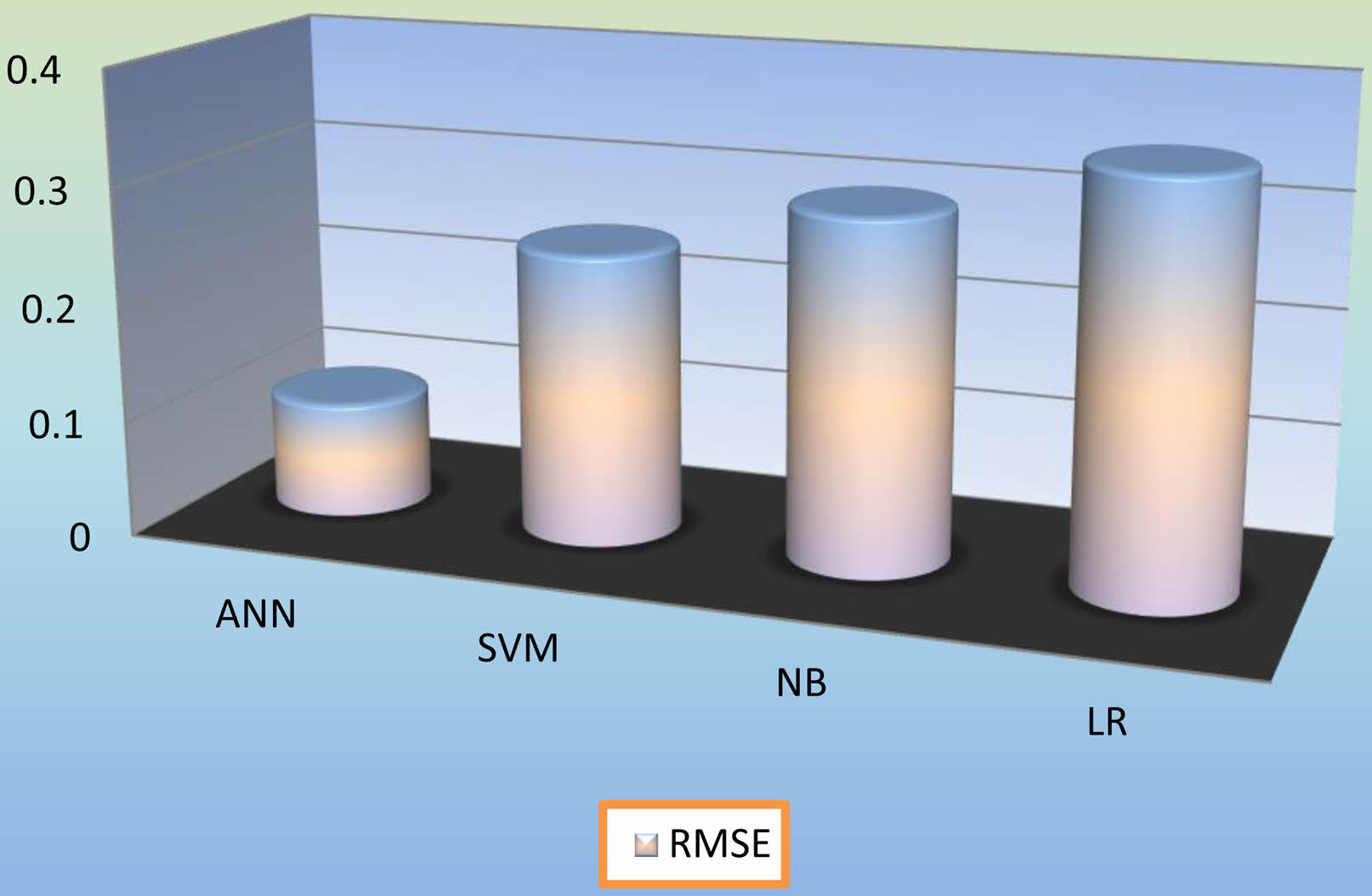
|
Fig. 8 RMSE of the models for specific heat capacity of Nano fluid. |
Several methods are involved here for creating nanofluids for heat transmission. Initially, the fluid dynamics cooling efficiency are required for single-phase fluids and crucial thermo-physical features for heat transfer. Next, examine how different nanofluid engineering factors affect the thermophysical characteristics of nanoparticle suspensions. Parameters affecting the specific heat capacity of several nanofluids are examined here, along with the suggested models. Unlike molten salts, where the specific heat capacity increases with increasing nanostructure volume fraction, typical base fluids see the opposite effect. Due to the nature of the base fluid, the heat capacity of nanofluid may either grow or reduce with heat. An analysis technique based on the thermal homeostasis or the concept of an ideal gas may be able to provide approximations of the specific heat capacity of nanofluids. Multiple correlations have been proposed as a means of more accurately estimating the specific heat capacity of nanofluids than is currently possible using analytical models. In order to more accurately mimic the specific heat of a nanofluid than can be done through correlations alone, a number of intelligent models have been devised. The model gets more generalizable as more variables are plugged into them. To reduce errors, modeling could be used in conjunction with a wide range of optimization strategies.
This work was supported by the Deanship of Scientific Research, Vice Presidency for Graduate Studies and Scientific Research, King Faisal University, Saudi Arabia [Grant No. 1177].
This work was supported by the Deanship of Scientific Research, Vice Presidency for Graduate Studies and Scientific Research, King Faisal University, Saudi Arabia [Grant No. 1177].
No violation of Human and Animal Rights is involved.
This work was supported by the Deanship of Scientific Research, Vice Presidency for Graduate Studies and Scientific Research, King Faisal University, Saudi Arabia [Grant No. 1177].
Conflict of Interest is not applicable in this work.
There is no authorship contribution
- 1. F. Ur Rehman, S. Nadeem, H. Ur Rehman, and R. Ul Haq, Results Phys. 8 (2018) 316-323.
-

- 2. L.A. Lund, Z. Omar, and I. Khan, Comput. Methods Programs Biomed. 182 (2019) 105044.
-

- 3. A. Naddaf, S.Z. Heris, and B. Pouladi, Powder Technol. 352 (2019) 369-380.
-

- 4. M. Gupta, V. Singh, S. Kumar, and N. Dilbaghi, J. Therm. Anal. Calorim. 142 (2020) 1545-1559.
-

- 5. R. Hentschke, Nanoscale Res. Lett. 11[1] (2016) 1-11.
-

- 6. N. Ali, Nanomaterials 12[3] (2022) 357.
-

- 7. A. Subaşı and K. Erdem, J. Fac. Eng. Archit. Gaz. 37[1] (2022).
-

- 8. H.-U.-R. Siddiqi, A. Qamar, R. Shaukat, Z. Anwar, M. Amjad, M. Farooq, M.M. Abbas, S. Imran, H. Ali, T.M.Y. Khan, F. Noor, H. Ali, M.A. Kalam, and M.E.M. Soudagar, Case Stud. Thermal Eng. 39 (2022) 102441.
-

- 9. L. Shi, S. Zhang, A. Arshad, Y. Hu, Y. He, and Y. Yan, Renew. Sust. Energ. Rev. 149 (2021) 111341.
-

- 10. A. Gandomkar, M.H. Saidi, M.B. Shafii, M. Vandadi, and K. Kalan, Appl. Thermal Eng. 116[3] (2017) 56-65.
-

- 11. P.R. Kshirsagar, H. Manoharan, F. Al-Turjman, and K. Kumar, IEEE Sensors J. 22 (2022) 17497-17504.
-

- 12. M.E.H. Assad and M.A. Nazari, in “Design and Performance Optimization of Renewable Energy Systems” (Cambridge, MA, USA: Academic Press, 2021) pp.33-42.
-

- 13. A.H. Saeedi, M. Akbari, and D. Toghraie, Physica E: Low-Dimens. Sys. Nanostruct. 99[10] (2018) 285-293.
-

- 14. A. Maleki, A. Haghighi, and I. Mahariq, J. Mol. Liq. 322[18] (2021) 114843-114853.
-

- 15. P. Kshirsagar and H. Manoharan, J. Environ. Protect. Eco. 22[2] (2021) 566-577.
- 16. P. Kshirsagar, N. Balakrishnan, and A.D. Yadav, Comput. Methods Biomech. Biomed. Engin. 8[4] (2020) 426-435.
-

- 17. B. Bakthavatchalam, K. Habib, R. Saidur, N. Aslfattahi, S.M. Yahya, A. Rashedi, and T. Khanam, Nanomaterials 11[2] (2021) 320-335.
-

- 18. Y. Zhou, H. Yang, L. Liu, M. Zhang, Y. Wang, Y. Zhang, and B. Zhou, Powder Technol. 384[4] (2021) 414-422.
-

- 19. A. Komeilibirjandi, A.H. Raffiee, A. Maleki, M.A. Nazari, and M. Safdari Shadloo, J. Therm. Anal. Calorim. 139[4] (2020) 2679-2689.
-

- 20. L. Sang, W. Ai, T. Liu, Y. Wu, and C. Ma, RSC Advances 9[10] (2019) 5288-5294.
-

- 21. P. Kshirsagar and S. Akojwar, ICCASP/ICMMD-2016. Adv. Intell. Sys. Res. 137 (2016) 385-394.
-

- 22. S. Akilu, A.T. Baheta, K. Kadirgama, E. Padmanabhan, and K.V. Sharma, J. Mol. Liq. 284 (2019) 780-792.
-

- 23. S. Sundaramurthy, C. Saravanabhavan, and Kshirsagar, P. 2020 International Conference on Decision Aid Sciences and Application (DASA) (2020) pp.17-21.
-

- 24. E. Bellos, C. Tzivanidis, and D. Tsimpoukis, Renew. Sust. Energy Rev. 91 (2018) 358-375.
-

- 25. D. Toghraie, N. Sina, N.A. Jolfaei, M. Hajian, and M. Afrand, Physica A 534 (2019) 122142.
-

- 26. S. Akojwar and P. Kshirsagar, Wseas Trans. Electron. 7 (2016) 79-84.
- 27. Z. Guo, J. Enhanc. Heat Transf. 27 (2020) 1-70.
 This Article
This Article
-
2023; 24(2): 359-366
Published on Apr 30, 2023
- 10.36410/jcpr.2023.24.2.359
- Received on Sep 19, 2022
- Revised on Jan 23, 2023
- Accepted on Feb 23, 2023
 Services
Services
- Abstract
introduction
review of literature
methodology
result and discussion
conclusion
- Acknowledgements
- Ethics Approval and Consent to Participate
- Human and Animal Rights
- Funding
- Conflict of Interest
- Author Contributions
- References
- Full Text PDF
Shared
 Correspondence to
Correspondence to
- Tawfiq Al-Mughanam
-
Department of Mechanical Engineering, College of Engineering, King Faisal University, Al-Ahsa 31982, Kingdom of Saudi Arabia
Tel : +966135895434 Fax: +966135896513 - E-mail: talmughanam@kfu.edu.sa, vtirth@kku.edu.sa







 Copyright 2019 International Orgranization for Ceramic Processing. All rights reserved.
Copyright 2019 International Orgranization for Ceramic Processing. All rights reserved.